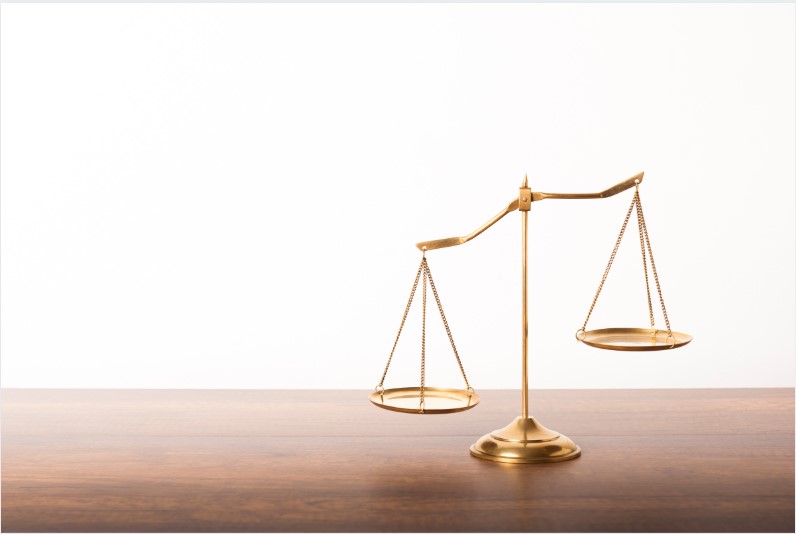
Is your portfolio well optimized with the right funds already?
Did the corona crisis put your financial plan off-track?
· Do you have a game plan for what happens if the emergency reserve runs dry?
· Would you like to optimize your portfolio to recover faster from the stock market crash?
· Is your insurance plan not immune to the Corona virus?
Let’s not focus on our suffering instead focus on overcoming of it.
Recover your financial life from Corona virus crisis with an actionable plan with our free consultation
Let’s see the positive developments during this crisis:
1. Low-interest rates
Reserve Bank of India changed the monetary policy to prevent economic collapse and to help liquidity in the economy. This time the loans have a lesser rate of interest. This adds to the advantage of the borrowers.
Businesses and farmers benefit, as they get business capital at a lesser rate which in turn increases production and output. Consumers pay less interest, this gives them more money to spend, which in turn increases sales. This, in turn, helps the companies and hence helps the stock market.
Investors and economists view this as a benefit to personal and corporate borrowing as it leads to economic growth. Low-interest rates hence help the stock market bounce back.
2. Fiscal Stimulus
The government financially stimulates an economy to kick-start growth during this time of crisis. It also credits money into the accounts of the poor to support businesses hit by the lockdown. India announced a $22.5 billion stimulus package to help people affected by lockdown.
3. Cheaper fuel prices
For crude oil-importing countries like India, it is a boon as it helps bring down our account deficit, fiscal deficit, and inflation. It reduces India’s foreign currency outflow, and interest rate pressure. It brings back economic activity and boosts the Indian Economy.
Eg: For every 1$ reduction in Crude, Rs.11,000 Crore is a benefit. So wherever crude oil is used, the production charges reduce and the product cost also reduces. Those goods would be available at cheaper prices.
4. Recoveries and normal functioning
In China (where the first corona case started), people recovered in large numbers. There are no fresh cases and death rates have come down. Most of the outlets are open again and are functioning as normal. This is one of the positive signs that we too will reach this position sooner and everything will get back to normal.
5. China’s & India’s GDP in 2021
All the countries’ GDP has come down due to recession. The International monetary fund (IMF) projected India’s growth at 7.4% in 2021. Amongst Emerging Market and Developing Economies (EMDEs) after Bangladesh and China, India stood third with the highest projected GDP for the year 2021.
Head start Portfolio Recovery by Re-balancing of asset allocation ratio.
Many investors usually invest randomly and have not approached their investments in a systematic or structured manner. A ratio that decides how much of your investments is equity investments while the rest being debt investments.
In usual market conditions, asset allocation ratio is barely altered until the annual review, if any.
But this stock market crash has pushed the asset allocation of every portfolio off its course. It did so by a big margin, meaning you have already taken in the risk.
Market recovery is certain. The stock market has suffered crashes in the past and has recovered every single time. That is a 100% success rate.
- You will recover from this Corona virus crash, too. But when will it happen?
- Are you going to wait for the stock market to recover like everybody else?
- Or are you going to use this re-balancing as a catalyst to speed up your recovery and get a head start?
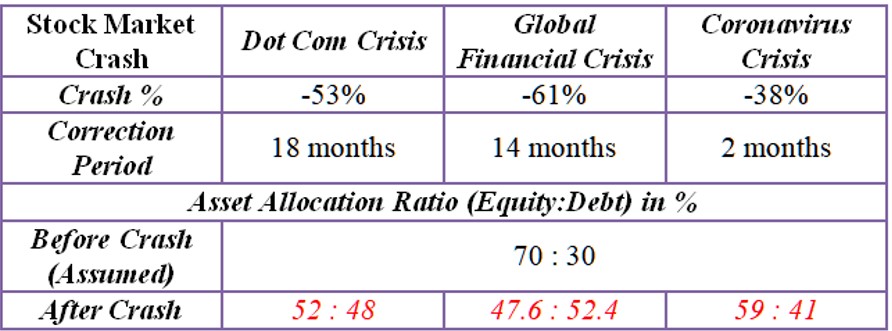
For example, let’s say an investor has an investment of $10,000 with this asset allocation ratio the day before the crash. I.e. Out of the $10,000 investments,
$7,000 are in equity mutual funds and $3,000 in debt investments.
By the time the stock market crash happened, the $7,000 equity investments dropped in value too. See the table below for the changes portfolio after the stock market crashes.
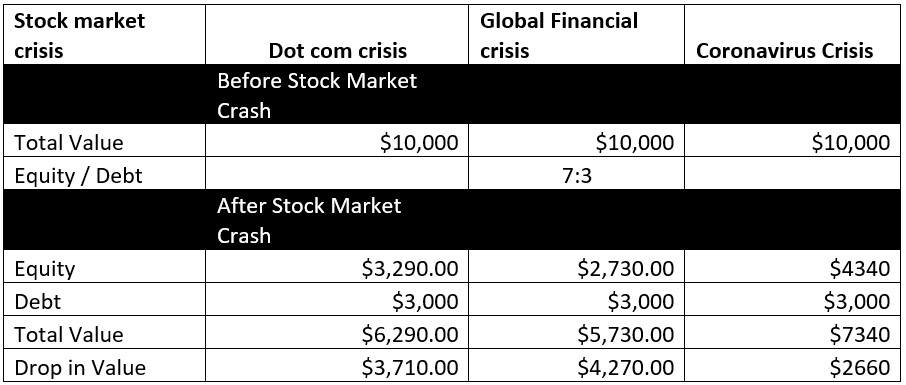
On seeing market crashes this big, any emotionally driven investor would have withdrawn his equity investments. The fact that $2,660 drop of the Corona virus crisis happened in just 2 months was a test of temperament for even the best of investors.
Despite, an average long-term investor would have kept continuing his regular investments. He will re-gain all of his investments—more or less at the same time as the market recovers.
How fast has the market recovered in the past?
Not as fast as it has crashed.
Two of the past stock market crashes seen in the example above were much slower than the current Corona virus crash. But they were even slower to recover.
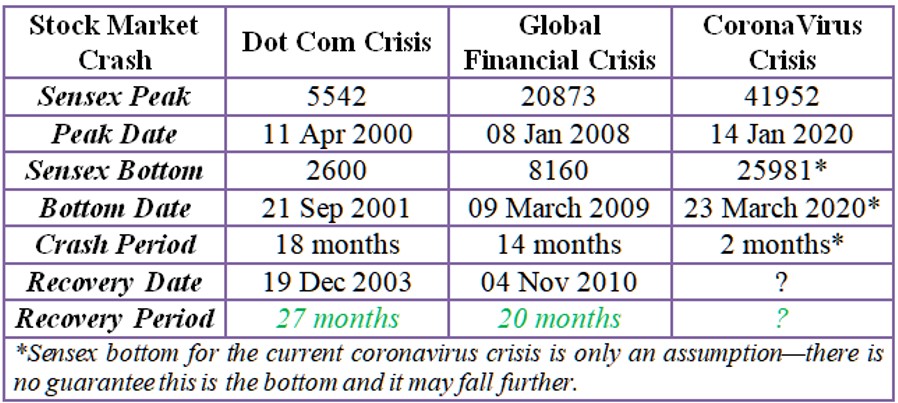
In the past 20 years, the average correction period is only 7 months. The average recovery period on the other hand is 16 months.
From peak to bottom to recovery, it takes 23 months. In other words, it is a 23 months delay in realising your financial goals.
But regardless of this, a proactive investor would have his asset allocation re-balanced, for he knows its outcome.
Are you willing to be a proactive investor?
Does re-balancing your portfolio make any positive difference?
See what we discovered below.
Re-balancing For Faster Portfolio Recovery
“It is impossible to produce superior performance unless you do something different from the majority.” – Sir John Templeton
Portfolio re-balancing can be done in two different ways.
You may either choose to transfer a portion of your debt investments into equity investments.
Or you may direct all your upcoming investments to only equity investment instruments until the desired asset allocation ratio is reached.
For simple understanding, I shall work out the re-balancing by transfer of investment for the example seen above.
Recovery without Portfolio Re-balancing:
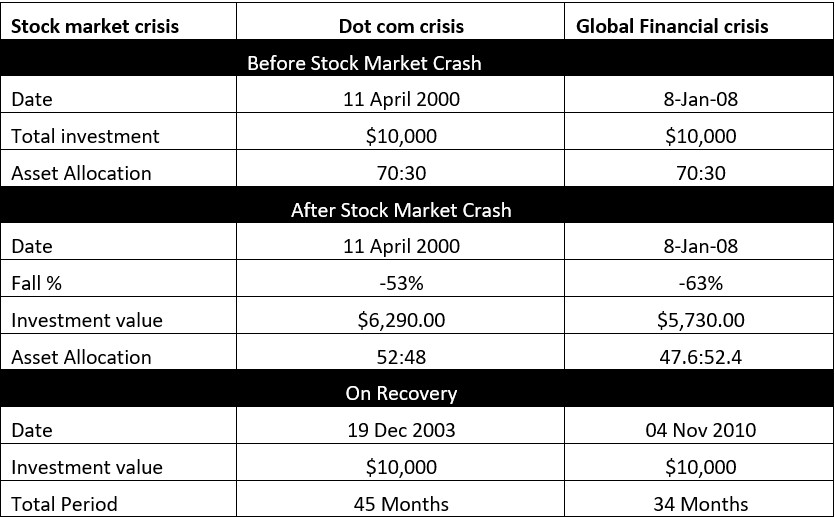
A lot has happened between the dates from before crash to recovery.
But if we look at the numbers, virtually no progress has happened.
In the Dot Com Crisis, after 45 long months, the total investment value was still only $10,000 The same goes for the Global Financial Crisis, too. After 34 months, the investment value was still $10,000.
Let’s see how things would have changed if we did the portfolio re-balancing.
Faster Recovery with Portfolio Re-balancing:
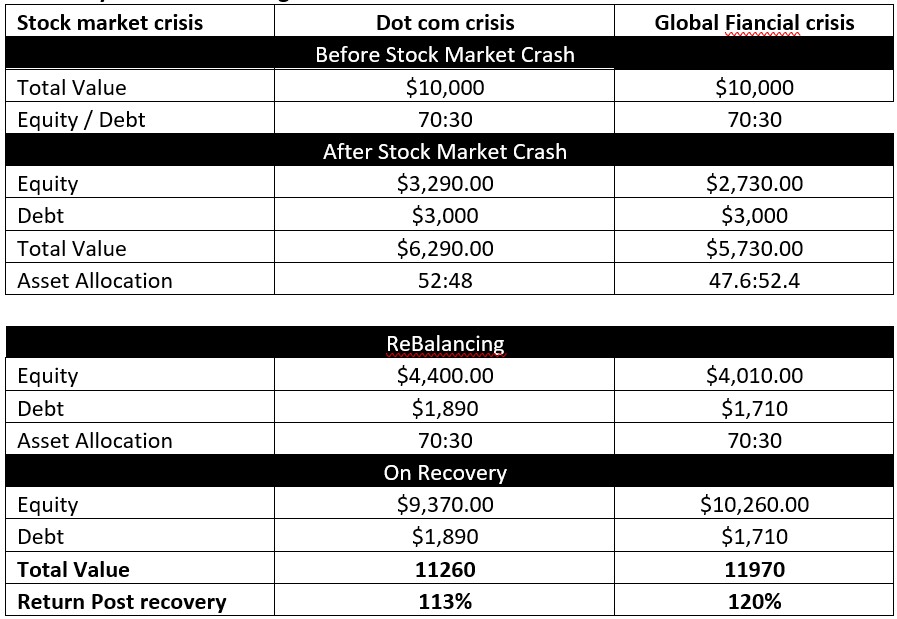
SO WHAT REALLY HAPPENED DURING THE RE–BALANCING
DOWN TRENDING MARKET? YOU BUY MORE……… SELL MORE…..
UP TRENDING MARKET? YOU BUY MORE……… SELL MORE…..
PRUDENT INVESTMENT = TIME + VOLATILITY + VALUE
HOW TO MANAGE “VOLATILITY”
= AUTO FUND BALANCING + DCA * VALUE
Here, we have re-balanced the asset allocation to bring back the equity allocation to 70% again after the market crash.
Also, you have to note that we have not considered the returns from the debt investments. They would have earned a return too while the equity market suffered the crash and recovered.
In both of the crashes, instead of only recovering the lost value the re-balanced portfolios have performed further and earned a return. And judging by the returns earned, the re-balanced portfolios will have recovered the lost value long before any other non re-balanced portfolio.
That is, while a typical investor is still recovering investments, a proactive investor will have already recovered and started seeing positive trends.
The 156% return post recovery, for example, is only a ballpark figure.
Any best performing actively managed mutual fund would have had even higher post recovery return—higher than 156%.
They tend to perform better than their benchmark or index consistently—be it in bear or bull market.
The positive side is that the best actively managed equity mutual funds may able to give you much higher post recovery returns.
If you are a proactive investor with optimized portfolio having only the actively managed best performing funds, expect a post recovery return much higher than the Sensex return.
How to Re-balance Your Portfolio for Better & Faster Recovery?
As stated earlier, you can re-balance your portfolio by two different methods.
You may either transfer your debt investments to equity or direct all your future investments to equity only.
Here’s the step by step procedure to re-balance your portfolio most optimally.
Steps to Re-balance Your Portfolio:
- Note your asset allocation ratio.
- Calculate the asset allocation ratio after the stock market crash.
- Have enough risk free funds to ensure liquidity for short term goals.
- Re-balance your portfolio by either,
- Transferring of funds from debt investments.OR
- Channelling new investments to only equity.
- Do the 50% of the re-balancing immediately.
- Do the rest of the re-balancing in a staggered manner.
- Continue your regular investments all this while.
You are free to follow any of the two methods of re-balancing.
But, if you want this re-balancing to be as effective as possible, I suggest transferring funds from debt to equity. It takes relatively very less time to increase the equity exposure.
However, you should do it in a regulated manner.
We do not know whether this coronavirus crash has hit the bottom or not. Hence you cannot dive in headfirst by re-balancing at once.
Instead, do the 50% of the rebalancing now by investing in the best equity fund(s) of your portfolio.
For the remaining portion of the rebalancing procedure, you can transfer the funds from debt to equity in a staggered manner. You may spread it over the next 3-6 months. This eliminates worry about finding the market bottom.
Initiate the portfolio rebalancing procedure and let your portfolio recover faster.
Call us for a discussion to rebalance your portfolio with our Portfolio Rebalancing Tool
for faster recovery.
Conclusion
Investor life is not a race against other investors but yourself.
It is important to be a better investor than yesterday. It is important to be ahead of the curve when you see the possibilities.
Being ahead of the curve, it is what made you an equity investor. The same attitude is going to make you recover faster from this coronavirus crash.
You have the facts. You have the time. You have the opportunity. And more importantly you have our guidance. Feel free to reach out to us to re-balance your portfolio for a better and faster recovery.






